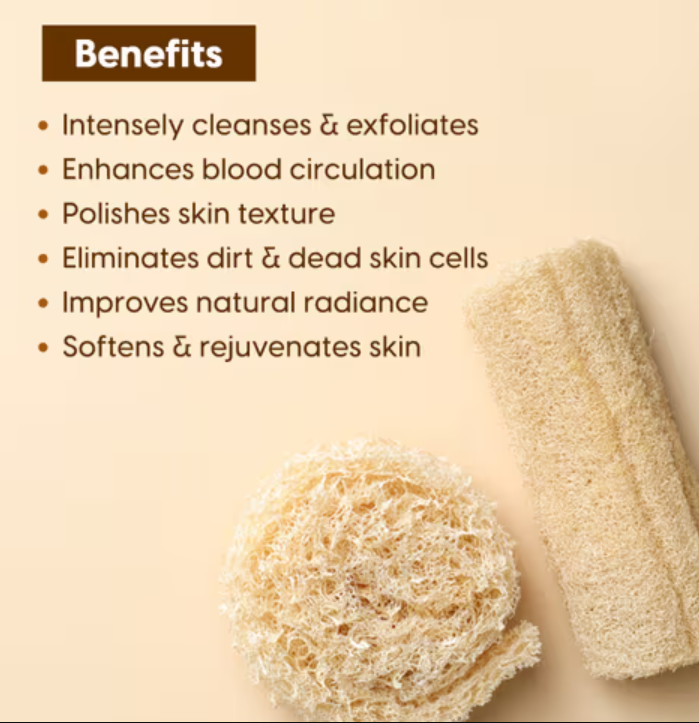Health
Luffa Sponge: Nature’s Versatile Wonder for Your Skin and Home
Published
11 months agoon
By
Bilal
A luffa sponge is a natural exfoliating tool derived from the fibrous interior of the luffa gourd, a vegetable closely related to cucumbers and pumpkins. Unlike synthetic sponges, luffa sponges are completely biodegradable and environmentally friendly, making them an increasingly popular choice for those who are conscious about their ecological footprint. With its natural texture and durability, the luffa sponge offers a unique blend of benefits for both personal care and household cleaning.
In this comprehensive guide, we’ll delve into the world of luffa sponges, exploring everything from their cultivation to their versatile uses. Whether you’re interested in growing your own luffa sponge plant or simply want to understand the benefits of using a natural luffa sponge, this article will provide you with all the information you need.
How to Grow a Luffa Sponge

Growing a luffa sponge is a rewarding experience that connects you directly with nature. Here’s a detailed guide on how to successfully cultivate your own luffa sponges:
- Choosing the Right Luffa Sponge Seeds: The first step in growing a luffa sponge is selecting high-quality seeds. You can find luffa sponge seeds at local gardening stores or order them online from reputable suppliers. Ensure the seeds are from a trusted source to guarantee good germination rates.
- Preparing the Soil: Luffa plants thrive in well-drained, fertile soil with a pH level between 6.0 and 6.8. Before planting, enrich the soil with organic compost or well-rotted manure to provide essential nutrients for the growing plants.
- Planting the Seeds: Sow the luffa sponge seeds directly in the garden after the last frost when the soil has warmed up to at least 60°F (16°C). If you live in a cooler climate, start the seeds indoors about 4-6 weeks before the last frost and transplant them outdoors once the weather permits. Plant the seeds about 1 inch deep and space them 12 inches apart to allow the vines to spread.
- Caring for the Luffa Sponge Plant: Luffa sponge plants require consistent watering, especially during dry periods. Water the plants deeply once or twice a week, ensuring the soil remains moist but not waterlogged. As the vines grow, they will need support from a trellis or fence to climb. This not only helps the plant grow more efficiently but also prevents the gourds from lying on the ground, which can lead to rot.
- Fertilization and Maintenance: To encourage healthy growth, feed the plants with a balanced fertilizer every 4-6 weeks during the growing season. Mulching around the base of the plants helps retain soil moisture and suppress weeds.
- Harvesting the Luffa Gourds: The luffa gourds are ready for harvest when the skin turns yellow or brown, and the gourd feels lightweight and hollow. This typically occurs about 150-200 days after planting. To harvest, cut the gourd from the vine using a sharp knife or garden shears, leaving a short stem attached.
| Step | Description |
|---|---|
| Choosing the Right Seeds | Select high-quality luffa sponge seeds from a reputable source to ensure good germination and healthy plant growth. |
| Preparing the Soil and Planting | Plant seeds in well-drained, fertile soil after the last frost, or start indoors 4-6 weeks earlier. Space 12-18 inches apart. |
| Watering and Care | Water consistently, ensuring the soil remains moist but not waterlogged. Provide support, such as a trellis, for the climbing vines. |
| Fertilization and Pruning | Fertilize every 4-6 weeks with a balanced fertilizer. Prune to remove yellowing leaves and improve air circulation. |
| Pollination | Ensure pollination by natural pollinators or hand-pollinate to increase fruit set. |
| Harvesting the Gourds | Harvest when the gourds turn yellow or brown and feel lightweight. Cut from the vine with a short stem attached. |
| Curing and Drying | Peel, clean, and dry the gourds thoroughly in the sun to prevent mold and prepare them for use as sponges. |
How to Make a Luffa Sponge
Transforming a luffa gourd into a functional sponge is a straightforward process that can be done at home. Here’s a step-by-step guide on how to make your own luffa sponge:
- Peeling the Gourd: After harvesting, the first step is to remove the outer skin of the gourd. If the skin is tough, you can soak the gourd in water for a few hours to soften it. Once softened, peel off the skin to reveal the fibrous interior.
- Removing the Seeds and Pulp: After peeling, cut the gourd open lengthwise and shake out the seeds. You can save these seeds for future planting. Then, rinse the interior of the gourd under running water to remove any remaining pulp and debris.
- Cleaning and Bleaching: To achieve a clean and bright luffa sponge, you can soak it in a solution of water and a small amount of bleach. This will help remove any remaining dirt and lighten the color of the fibers. After soaking, rinse the sponge thoroughly to remove any bleach residue.
- Drying the Luffa Sponge: Lay the cleaned luffa sponges out in the sun to dry completely. Sun drying not only ensures that the sponge is thoroughly dried but also helps in naturally sanitizing it. This process may take a few days, depending on the climate.
- Final Preparation: Once dried, you can cut the luffa into smaller pieces depending on your intended use. For a softer texture, soak the sponge in warm water before using it for the first time.
Luffa Sponge Benefits

The luffa sponge is celebrated for its numerous benefits, making it a versatile addition to both personal care routines and household cleaning tasks. Here are some of the key advantages:
- Exfoliation: Luffa sponges are excellent natural exfoliators. They help slough away dead skin cells, promoting smoother and more radiant skin. Regular exfoliation with a luffa sponge can also help prevent clogged pores and ingrown hairs.
- Eco-Friendly: Unlike synthetic sponges, which are often made from plastic and take hundreds of years to decompose, luffa sponges are 100% biodegradable. This makes them an environmentally friendly choice for those looking to reduce their waste and carbon footprint.
- Chemical-Free: Luffa sponges are all-natural, free from harmful chemicals, dyes, or synthetic materials. This makes them a safer option for people with sensitive skin or allergies to synthetic products.
- Versatility: Luffa sponges are incredibly versatile and can be used for a wide range of purposes. Whether you need a gentle exfoliator for your skin, a durable scrubber for your dishes, or a natural cleaning tool for your home, the luffa sponge has you covered.
- Affordable and Renewable: Growing your own luffa sponges is a cost-effective way to ensure a constant supply of natural sponges. With just a few seeds and some garden space, you can cultivate enough luffa gourds to last you an entire year.
- Antimicrobial Properties: Some studies suggest that luffa sponges may have natural antimicrobial properties, which can help reduce the growth of bacteria on the sponge itself. However, it’s still essential to clean and sanitize your luffa regularly to maintain its hygiene.
| Benefit | Description |
|---|---|
| Natural Exfoliation | Gently removes dead skin cells, promoting smoother, more radiant skin and improving circulation. |
| Environmentally Friendly | 100% biodegradable and compostable, reducing plastic waste and supporting a sustainable lifestyle. |
| Chemical-Free and Hypoallergenic | Free from harmful chemicals, dyes, and synthetic materials, making it safe for sensitive skin and less likely to cause irritation. |
| Versatile Use | Suitable for various applications, including skincare, dishwashing, and household cleaning. |
| Affordable and Renewable | Cost-effective to grow and renewable, providing a continuous supply of natural sponges with minimal environmental impact. |
| Antimicrobial Properties | Natural fibers may reduce the growth of bacteria and fungi, promoting hygiene in personal care and cleaning tasks. |
| Enhances Soap Efficiency | Helps create a rich lather, making soaps and body washes last longer and perform more effectively. |
| Improves Blood Circulation | Stimulates circulation, promoting cell renewal and overall skin health, while reducing the appearance of cellulite. |
| Aromatherapy and Relaxation | Enhances relaxation during baths or showers when paired with essential oils or scented body washes, creating a spa-like experience. |
Luffa Sponge Plant: A Closer Look
The luffa sponge plant is a vigorous, climbing vine that can reach impressive heights if given the right conditions. Here’s a closer look at this fascinating plant:
- Botanical Name: The luffa sponge plant belongs to the genus Luffa, with the most common species used for sponges being Luffa aegyptiaca and Luffa acutangula.
- Climate Requirements: Luffa plants thrive in warm, tropical climates with plenty of sunlight. They require a long growing season of at least 150-200 frost-free days, making them well-suited to regions with hot summers.
- Growth Habit: The luffa vine can grow up to 30 feet (9 meters) in length and requires sturdy support, such as a trellis, fence, or arbor, to climb. The plant produces large, yellow flowers that are pollinated by bees and other insects.
- Fruit Development: The luffa gourds develop from the fertilized flowers and grow rapidly during the summer months. Depending on the variety, the gourds can reach lengths of up to 24 inches (60 cm) or more.
- Harvesting and Curing: Once the gourds are fully mature, they can be harvested and cured to create sponges. Curing involves allowing the gourds to dry and harden before processing them into sponges.
Luffa Sponge Color Meaning
The color of a luffa sponge can vary depending on factors such as its maturity, the method of processing, and its intended use. Here’s a breakdown of what different luffa sponge colors might signify:
- Light Beige or Cream: A fresh, young luffa sponge that is soft and gentle on the skin. This color is typical of luffas that have been harvested early and processed quickly.
- Golden Yellow: A more mature luffa sponge that has been fully ripened before harvest. This color indicates a denser, more fibrous texture, making it ideal for more robust exfoliation or cleaning tasks.
- Brown or Dark Beige: Luffas that have been sun-dried or aged longer may take on a darker color. These sponges are often tougher and more abrasive, suitable for scrubbing tough stains or rough surfaces.
- Green Tint: Occasionally, luffas may retain a slight greenish hue if they were harvested before fully ripening. These sponges tend to be softer and less abrasive, making them ideal for sensitive skin or delicate cleaning tasks.
A luffa sponge is an all-natural exfoliating tool made from the fibrous interior of the luffa gourd, a plant closely related to cucumbers and pumpkins. Unlike synthetic sponges, luffa sponges are biodegradable, renewable, and environmentally friendly. They offer a wide range of benefits, from skincare to household cleaning, making them a popular choice for those looking to adopt a more sustainable lifestyle. This comprehensive guide will explore the cultivation, uses, benefits, and nuances of luffa sponges, providing a complete overview of why this natural product should be a staple in every home.
Conclusion
Luffa sponges are much more than just a tool for your bathroom or kitchen. They represent a return to natural, sustainable living. With their ability to gently exfoliate the skin. Effectively clean household surfaces, and reduce environmental impact, luffa sponges are a versatile and eco-friendly alternative to synthetic products. Whether you’re interested in enhancing your skincare routine, finding a natural cleaning solution. Simply contributing to a more sustainable world, luffa sponges offer numerous benefits that make them an excellent choice.

Who Is Lynn Hamilton? Celebrating the Life and Legacy of the American Actress

Who is Mickey Gooch Jr? The Dynamic Journey of a Film Producer and Actor

Who Is Pierre Bouvier? All About the Canadian Singer and Musician Behind Simple Plan

Who Is Pearl Minnie Anderson? Rising Star in Maya Rudolph’s Legacy

Who is Minnie Pearl? The American Comedian Who Brought Country Humor to the Spotlight

Who Is Kavan Smith? The Canadian Actor Known for His Versatile Roles

Who is Olivia Rose Cameron: The Creative Artist & Daughter of Kirk Cameron

Who Is Markella Kavenagh? All About the Australian Actress and Rising Star

Who is Tracey Hinds? Exploring the Life of Macy Gray’s Ex-Husband and Mortgage Broker

Who is Eric Weinberger? A Visionary Television Producer Shaping Sports Media

Who Is Dan Jeannotte? All About the Canadian Actor’s Career and Roles

Who Is Paul Fenech? Inside the World of the Australian Filmmaker and Actor

Who Is Merri Kelly Hannity? All About Sean Hannity’s Daughter

Who Is Diana Espinoza Aguilar? The Story of Rafael Caro Quintero’s Wife

Who Is James Lesure? All About the American Film and Television Actor

Who is Charlee Fraser? The Rise of the Australian Model and Actress Making Global Waves

Who is Eric Weinberger? A Visionary Television Producer Shaping Sports Media

Who Is Toru Ohtani? All About Shohei Ohtani’s Father & Baseball Coach

Who is Torrei Hart? The Multitalented Actress and Comedian Making Waves

Who Is Avantika Vandanapu? Rising American Actress & Singer

Who Is Lynn Hamilton? Celebrating the Life and Legacy of the American Actress

Who is Mickey Gooch Jr? The Dynamic Journey of a Film Producer and Actor

Who Is Pierre Bouvier? All About the Canadian Singer and Musician Behind Simple Plan

Who Is Pearl Minnie Anderson? Rising Star in Maya Rudolph’s Legacy

Who is Minnie Pearl? The American Comedian Who Brought Country Humor to the Spotlight

Who Is Kavan Smith? The Canadian Actor Known for His Versatile Roles

Who is Olivia Rose Cameron: The Creative Artist & Daughter of Kirk Cameron

Who Is Markella Kavenagh? All About the Australian Actress and Rising Star

Who is Tracey Hinds? Exploring the Life of Macy Gray’s Ex-Husband and Mortgage Broker

Who is Eric Weinberger? A Visionary Television Producer Shaping Sports Media
Trending
-

 Celebrity11 months ago
Celebrity11 months agoNecati Arabacı: Net Worth, Biography, and More
-

 Celebrity1 year ago
Celebrity1 year agoDiscovering Lily Phillips: An Insight into Her Life and Career
-

 Celebrity12 months ago
Celebrity12 months agoParker Schnabel’s Girlfriend: A Comprehensive Look at His Relationships Over the Years
-

 Celebrity11 months ago
Celebrity11 months agoEnrica Cenzatti: Life of Andrea Bocelli’s Ex-Wife
